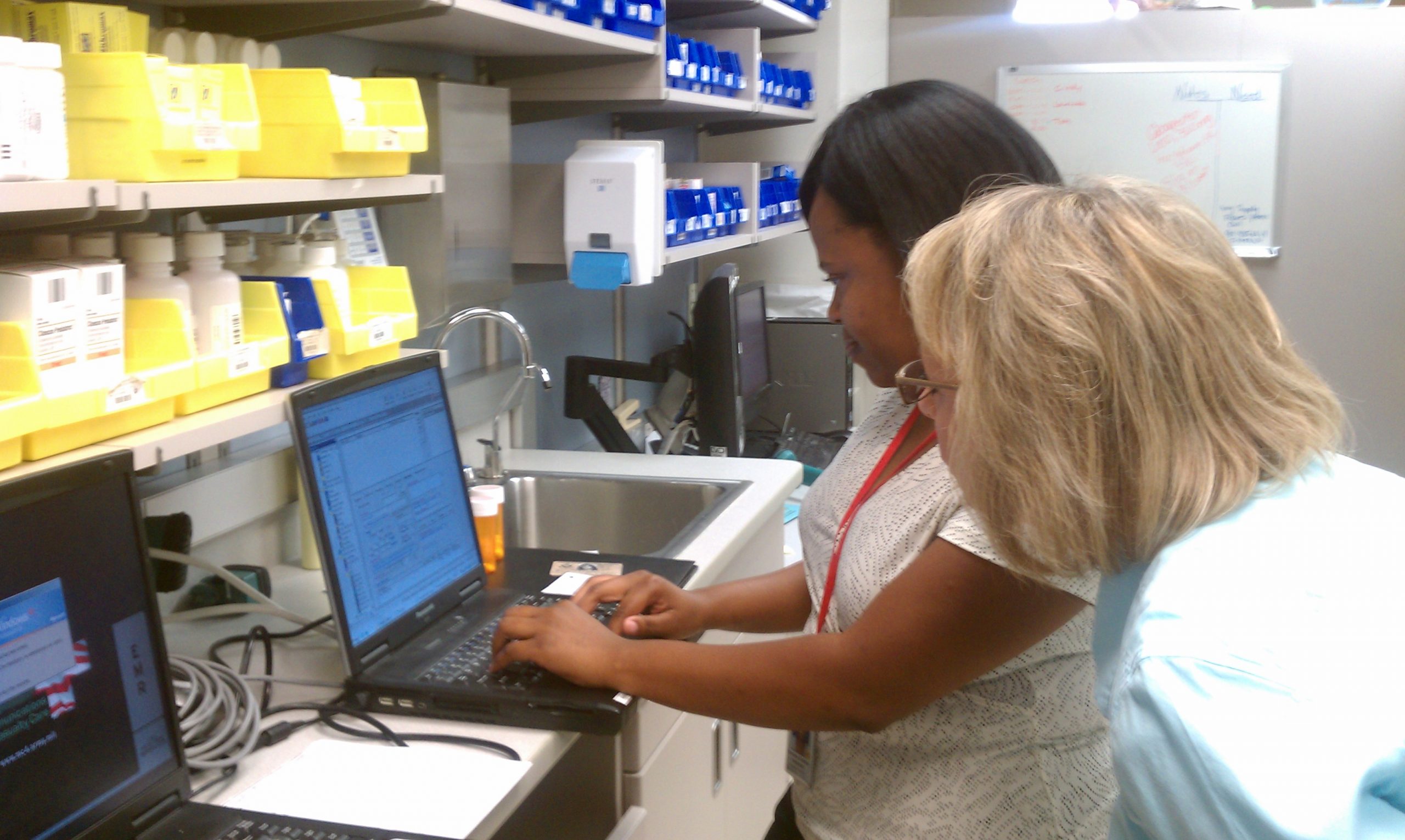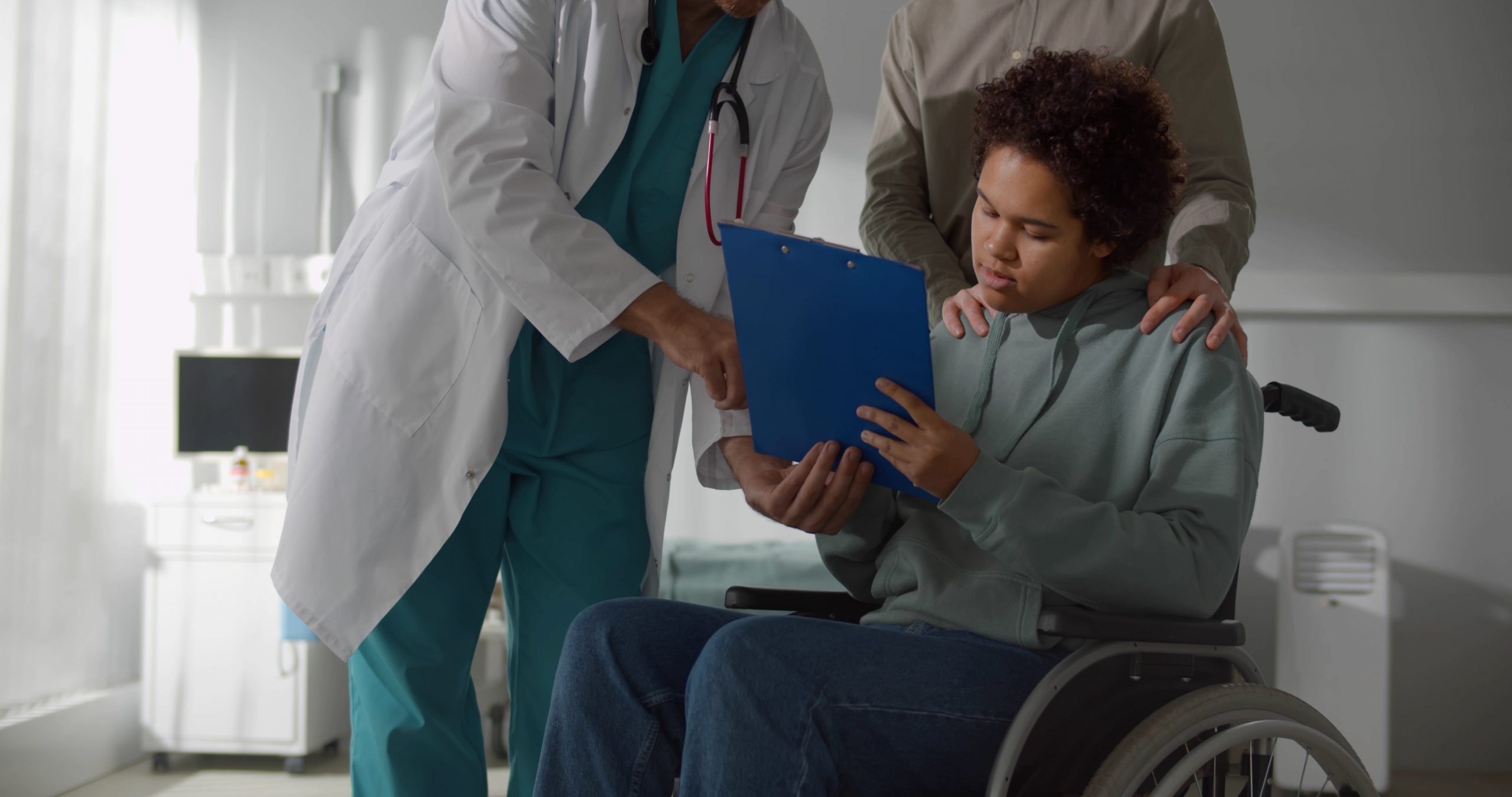Using Technology to Access Information
Most patient information in acute care, long-term care, and other clinical settings is now electronic and uses intranet technology for secure access by providers, nurses, and other health care team members to maintain patient confidentiality. Intranet refers to a private computer network within an institution. An electronic health record (EHR) is a real-time, patient-centered record that makes information available instantly and securely to authorized users.[1] Computers used to access an EHR can be found in patient rooms, on wheeled carts, in workstations, or even on handheld devices. See Figure 2.11[2] for an image of a nurse documenting in an EHR.

The EHR for each patient contains a great deal of information. The most frequent pieces of information that nurses access include the following:
- History and Physical (H&P): A history and physical (H&P) is a specific type of documentation created by the health care provider when the patient is admitted to the facility. An H&P includes important information about the patient’s current status, medical history, and the treatment plan in a concise format that is helpful for the nurse to review. Information typically includes the reason for admission, health history, surgical history, allergies, current medications, physical examination findings, medical diagnoses, and the treatment plan.
- Provider orders: This section includes the prescriptions, or medical orders, that the nurse must legally implement or appropriately communicate according to agency policy if not implemented.
- Medication Administration Records (MARs): Medications are charted through electronic medication administration records (MARs). These records interface the medication orders from providers with pharmacists and are also the location where nurses document medications administered.
- Treatment Administration Records (TARs): In many facilities, treatments are documented on a treatment administration record.
- Laboratory results: This section includes results from blood work and other tests performed in the lab.
- Diagnostic test results: This section includes results from diagnostic tests ordered by the provider such as X-rays, ultrasounds, etc.
- Progress notes: This section contains notes created by nurses and other health care providers regarding patient care. It is helpful for the nurse to review daily progress notes by all team members to ensure continuity of care.
View a video of how to read a patient’s chart.[3]
Legal Documentation
Nurses and health care team members are legally required to document care provided to patients. In a court of law, the rule of thumb used is, “If it wasn’t documented, it wasn’t done.” Documentation should be objective, factual, professional, and use proper medical terminology, grammar, and spelling. All types of documentation must include the date, time, and signature of the person documenting. Any type of documentation in the EHR is considered a legal document and must be completed in an accurate and timely manner. Abbreviations should be avoided in legal documentation.
Documentation is used for many purposes. It is used to ensure continuity of care across health care team members and across shifts; monitor standards of care for quality assurance activities; and provide information for reimbursement purposes by insurance companies, Medicare, and Medicaid. Documentation may also be used for research purposes or, in some instances, for legal concerns in a court of law.
Documentation by nurses includes recording patient assessments, writing progress notes, and creating or addressing information included in nursing care plans. Nursing care plans are further discussed in the “Planning” section of the “Nursing Process” chapter.
Common Types of Documentation
Common formats used to document patient care include charting by exception, focused DAR notes, narrative notes, SOAPIE progress notes, patient discharge summaries, and Minimum Data Set (MDS) charting.
Charting by Exception
Charting by exception (CBE) documentation was designed to decrease the amount of time required to document care. CBE contains a list of normal findings. After performing an assessment, nurses confirm normal findings on the list found on assessment and write only brief progress notes for abnormal findings or to document communication with other team members.
Focused DAR Notes
Focused DAR notes are a type of progress note that are commonly used in combination with charting by exception documentation. DAR stands for Data, Action, and Response. Focused DAR notes are brief. Each note is focused on one patient problem for efficiency in documenting and reading.
- Data: This section contains information collected during the patient assessment, including vital signs and physical examination findings found during the “Assessment” phase of the nursing process. The Assessment phase is further discussed in the “Nursing Process” chapter.
- Action: This section contains the nursing actions that are planned and implemented for the patient’s focused problem. This section correlates to the “Planning” and “Implementation” phases of the nursing process and are further discussed in the “Nursing Process” chapter.
- Response: This section contains information about the patient’s response to the nursing actions and evaluates if the planned care was effective. This section correlates to the “Evaluation” phase of the nursing process that is further discussed in the “Nursing Process” chapter.
View sample charting by exception paper documentation with associated DAR notes for abnormal findings.
For more information about writing DAR notes, visit What is F-DAR Charting?
View a video explaining F-DAR charting.[4]
Narrative Notes
Narrative notes are a type of progress note that chronicles assessment findings and nursing activities for the patient that occurred throughout the entire shift or visit. View sample narrative note documentation according to body system in each assessment chapter of the Open RN Nursing Skills textbook.
SOAPIE Notes
SOAPIE is a mnemonic for a type of progress note that is organized by six categories: Subjective, Objective, Assessment, Plan, Interventions, and Evaluation. SOAPIE progress notes are written by nurses, as well as other members of the health care team.
- Subjective: This section includes what the patient said, such as, “I have a headache.” It can also contain information related to pertinent medical history and why the patient is in need of care.
- Objective: This section contains the observable and measurable data collected during a patient assessment, such as the vital signs, physical examination findings, and lab/diagnostic test results.
- Assessment: This section contains the interpretation of what was noted in the Subjective and Objective sections, such as a nursing diagnosis in a nursing progress note or the medical diagnosis in a progress note written by a health care provider.
- Plan: This section outlines the plan of care based on the Assessment section, including goals and planned interventions.
- Interventions: This section describes the actions implemented.
- Evaluation: This section describes the patient response to interventions and if the planned outcomes were met.
Patient Discharge Summary
When a patient is discharged from an agency, a discharge summary is documented in the patient record, along with clear verbal and written patient education and instructions provided to the patient. Discharge summary information is frequently provided in a checklist format to ensure accuracy and includes the following:
- Time of departure and method of transportation out of the hospital (e.g., wheelchair)
- Name and relationship of person accompanying the patient at discharge
- Condition of the patient at discharge
- Patient education completed and associated educational materials or other information provided to the patient
- Discharge instructions on medications, treatments, diet, and activity
- Follow-up appointments or referrals given
See Figure 2.12[5] for an image of a nurse providing discharge instructions to a patient. Discharge teaching typically starts at admission and continues throughout the patient’s stay.

Minimum Data Set (MDS) Charting
In long-term care settings, additional documentation is used to provide information for reimbursement by private insurance, Medicare, and Medicaid. The Resident Assessment Instrument Minimum Data Set (MDS) is a federally mandated assessment tool created by registered nurses in skilled nursing facilities to track a patient’s goal achievement, as well as to coordinate the efforts of the health care team to optimize the resident’s quality of care and quality of life.[6] This tool also guides nursing care plan development.
- HealthIT.gov. (2019, September 10). What is an electronic health record (EHR)? https://www.healthit.gov/faq/what-electronic-health-record-ehr ↵
- "Winn_Army_Community_Hospital_Pharmacy_Stays_Online_During_Power_Outage.jpg" by Flickr user MC4 Army is licensed under CC BY 2.0 ↵
- RegisteredNurseRN. (2015, October 16). Charting for nurses | How to understand a patient's chart as a nursing student or new nurse. [Video]. YouTube. All rights reserved. Video used with permission. https://youtu.be/lNwRvKaNsGc ↵
- RegisteredNurseRN. (2015, October 27). FDAR for nurses | How to chart in F-DAR format with examples. [Video]. YouTube. All rights reserved. Video used with permission. https://youtu.be/BXf7wj9Wmfc ↵
- "1934626790-huge.jpg" by TommyStockProject is used under license from Shutterstock.com ↵
- Centers for Medicare & Medicaid Services. (2019, October). Long-term care facility resident assessment instrument 3.0 user’s manual. https://downloads.cms.gov/files/mds-3.0-rai-manual-v1.17.1_october_2019.pdf ↵
A digital version of a patient’s paper chart. EHRs are real-time, patient-centered records that make information available instantly and securely to authorized users.
A type of documentation where a list of “normal findings” are provided and nurses document assessment findings by confirming normal findings and writing brief documentation notes for any abnormal findings.
A type of documentation often used in combination with charting by exception. DAR stands for Data, Action, and Response. Focused DAR notes are brief and each note is focused on one patient problem for efficiency in documenting, as well as for reading.
A type of documentation that chronicles all of the patient’s assessment findings and nursing activities that occurred throughout the shift.
A mnemonic for a type of documentation that is organized by four categories: Subjective, Objective, Assessment, ,Plan, Interventions, and Evaluation.
A federally mandated assessment tool used in skilled nursing facilities to track a patient’s goal achievement, as well as to coordinate the efforts of the health care team to optimize the resident’s quality of care and quality of life.

